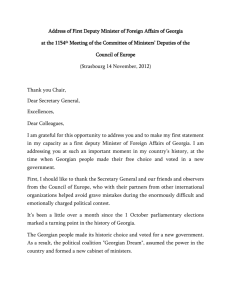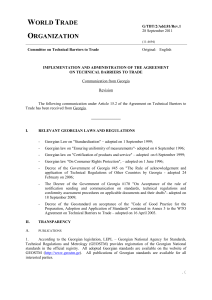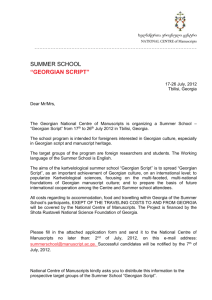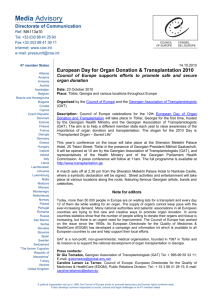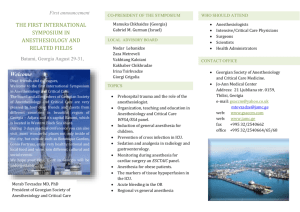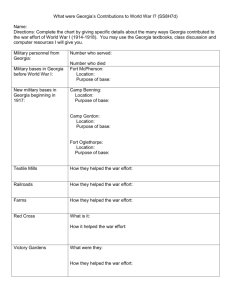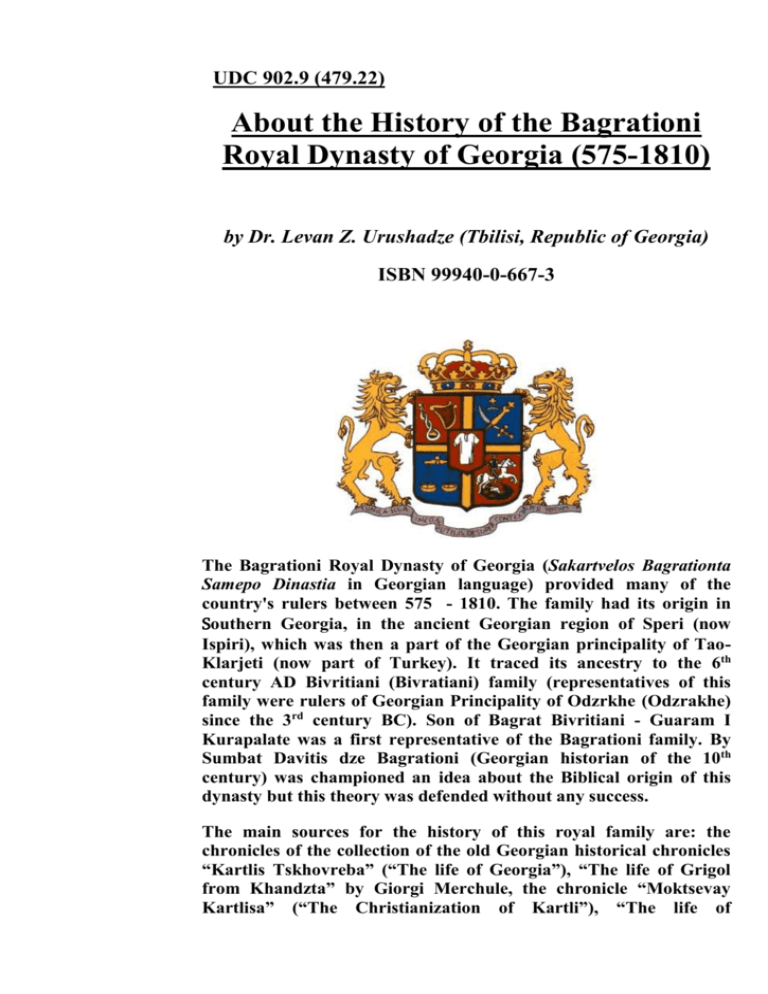
UDC 902.9 (479.22)
About the History of the Bagrationi
Royal Dynasty of Georgia (575-1810)
by Dr. Levan Z. Urushadze (Tbilisi, Republic of Georgia)
ISBN 99940-0-667-3
The Bagrationi Royal Dynasty of Georgia (Sakartvelos Bagrationta
Samepo Dinastia in Georgian language) provided many of the
country's rulers between 575 - 1810. The family had its origin in
Southern Georgia, in the ancient Georgian region of Speri (now
Ispiri), which was then a part of the Georgian principality of TaoKlarjeti (now part of Turkey). It traced its ancestry to the 6th
century AD Bivritiani (Bivratiani) family (representatives of this
family were rulers of Georgian Principality of Odzrkhe (Odzrakhe)
since the 3rd century BC). Son of Bagrat Bivritiani - Guaram I
Kurapalate was a first representative of the Bagrationi family. By
Sumbat Davitis dze Bagrationi (Georgian historian of the 10th
century) was championed an idea about the Biblical origin of this
dynasty but this theory was defended without any success.
The main sources for the history of this royal family are: the
chronicles of the collection of the old Georgian historical chronicles
“Kartlis Tskhovreba” (“The life of Georgia”), “The life of Grigol
from Khandzta” by Giorgi Merchule, the chronicle “Moktsevay
Kartlisa” (“The Christianization of Kartli”), “The life of
Bagrationi’s of Tao-Klarjeti” by Sumbat Davitis dze, “History of
Georgia” by Vakhushti Bagrationi, etc.
1. Erismtavars (Grand Dukes) of Kartli (575-605, 786-809)
The first representative of the Bagrationi family Guaram I Kurapalate was a
Grand Duke of Kartli (Kartlis Erismtavari in Georgian) in 575-590. His mother
was a daughter of Vakhtang I Gorgasali - a king of Georgia from the dynasty of
Parnavazians. Other Erismtavars of Kartli from the Bagrationi family were:
* Stepanoz I Kurapalate (590-605)
* Ashot I Kurapalate (786-809)
2. Eristavteristavs (Grand Dukes) of Klarjeti (619-779)
In 619-678 Guaram II, a son of Stepanoz I was a Grand Duke of the Georgian
Principality of Klarjeti (Klarjetis Eristavteristavi in Georgian). Other Grand
Dukes of this Principality from the Bagrationi family were:
* Varazbakur (678-705)
* Nerse (705-742)
* Adarnase (742-779)
3. Kingdom of Tao-Klarjeti (“Tao-Klarjetis Samepo”) (809888)
Ashot I the Great (also known as Ashot I Kurapalate) was the first Bagrationi to
become a king, founding the royal dynasty in 809. He ruled the kingdom of TaoKlarjeti and dead in 826, in Doliskana. His father was Adarnase Bagrationi
(Eristavteristavi (Grand Duke) of Klarjeti). Other Kings of Tao-Klarjeti were:
* Bagrat I (826-876. In 826-869 co-ruler of the Kingdom of Tao-Klarjeti was
Adarnase I)
* David I Kurapalate (876-881)
* Adarnase II (881-888)
4. "Kingdom of Georgians" (“Kartvelta Samepo”) (888- 978
(1008))
In 888 the "Kingdom of Georgians" (Kartvelta Samepo in Georgian) was
founded, incorporating the regions of Samtskhe-Javakheti, Kola-Artaani,
Shavsheti, Tao-Klarjeti, Basiani, Speri and Tortomi (Tortumi). Its first ruler,
who took the title "King of Georgians", was Adarnase II (888-923). Other
rulers of this kingdom were:
* David II (923-937)
* Bagrat Magistros (937-945. Without of the official title of King)
* Ashot IV (945-954)
* Sumbat I (954-958)
* Bagrat II (958-975. Co-rulers: Adarnase III in 961-966 and David III in 966975)
* Gurgen II (975-1008. Co-ruler was his son Bagrat III, since 978 also a King of
the Kingdom of Western Georgia - Kingdom of Abkhazeti).
5. United Georgian Kingdom (“Sakartvelos Ertiani
Samepo”) (978-1466)
The United Kingdom of Georgia was established in 978. In this year Bagrat III
(a son of Gurgen II) become a ruler of the Kingdom of Western Georgia
(Kingdom of Abkhazeti – “Apkhazetis Samepo”), including the Principalities of
Imereti, Samegrelo, Abkhazeti (Abkhazia), Guria and Svaneti. Bagrat's mother
was Queen Gurandukht, a daughter of Giorgi II of Abkhazeti. The Bagrationis
went on to provide a series of notable kings and queens of Georgia, particularly
David the Builder, Tamar of Georgia and others. In 1204 Queen Tamar was a
main founder of the Empire of Trabizond (now part of Turkey). The XI-XIII
centuries are named the Gold Age (“Okros Khana” in Georgian) of the history
of Georgia of Middle Ages. Then it was an one of the mighty states of whole
Asia Minor.
GREATEST RULERS OF THE UNITED GEORGIAN KINGDOM: DAVID
IV THE BUILDER (1089-1125) AND TAMAR (1184-1213)
Kings of the United Georgian Kingdom from the Bagrastioni dynasty were:
* Bagrat III (978-1014)
* Giorgi I (1014-1027)
* Bagrat IV (1027-1072)
* Giorgi II (1072-1089)
* David IV the Builder (Agmashenebeli) (1089-1125)
* Demetre I (1125-1155)
* David V (1155-1156)
* Giorgi III (1156-1184)
* Queen Tamar (1184-1213)
* Giorgi IV Lasha (1213-1223)
* Rusudan (1223-1245)
* David VI Narini (1245-1293)
* David VII Ulu (1247-1270)
* Demetre II (1271-1289)
* Vakhtang II (1289-1293)
* David VIII (1293-1299, 1300-1308)
* Giorgi VI (1308-1313)
* Giorgi V (1299, 1314-1346)
* David IX (1346-1360)
* Bagrat V (1360-1393)
* Giorgi VII (1393-1407)
* Konstantine I (1407-1411)
* Alexandre I the Great (1412-1442)
* Vakhtang IV (1442-1446)
* Giorgi VIII (1446-1466)
In 1466 the United Georgian Kingdom was destroyed and were founded the
separate Kingdoms of Imereti, Kartli and Kakheti under ruling of Bagrations.
6. Kings of Kartl-Imereti
Kings of Kartl-Imereti (Western Georgia and a part of Eastern Georgia) were:
* Bagrat II (1466-1478)
* Konstantine II (1478-1484)
7. Kings of Imereti
Founder of the Imeretian line (Western Georgia) of Bagrationi family was
David VI Narini (David I in Imereti). He was ruler of Western Georgia
(including the Principality of Imereti) in 1259-1293. In 1293-1327 a Duke
(Eristavi) of the Imeretian Principality was his son Konstantine I. In 1293-1392
Imereti was a Principality (not a Kingdom) in the United Georgian Kingdom.
Other Dukes of this Principality were: Mikel (1327-1329), Bagrat I (1329-1372),
Alexandre I (1372-1389) and Giorgi I (1389-1392).
COAT OF ARMS OF THE KINGDOM OF IMERETI
Since 1484 the Kings of Imereti were:
* Alexandre II (1484-1510)
* Bagrat III (1510-1565)
* Giorgi II (1565-1585)
* Levan (1585-1590)
* Rostom (1590-1604)
* Giorgi III (1605-1639)
* Alexandre III (1639-1660)
* Bagrat IV (1660-1661, 1663-1678, 1679-1681)
* Archil II (from the Bagration-Mukhraneli family. 1661-1663, 1678, 1690,
1695, 1698)
* Alexandre IV (1683-1690, 1691-1695)
* Giorgi IV (1696-1697)
* Svimon (1698-1701)
* Giorgi VI (1707-1711, 1713, 1716-1720)
* Alexandre V (1720-1740, 1741-1752)
* Giorgi VII (1741)
* Solomon I (1752-1784)
* David II (1784-1789, 1792)
* Solomon II (1789-1810)
In 1701-1707 the real Governer of the Kingdom of Imereti was Prince GiorgiMalakia Abashidze (Giorgi V).
8. Kings of Kartli
THE FLAG OF THE KINGDOM OF KARTLI
Kings of Kartli (Eastern Georgia) were:
* Konstantine II (1484-1505)
* David X (1505-1525)
* Giorgi IX (1525-1527)
* Luarsab I (1527-1556)
* Simon I (1556-1569, 1578-1600)
* David XI (1569-1578)
* Giorgi X (1600-1606)
* Luarsab II (1606-1615)
* Bagrat VII (1615-1619)
* Simon II (1619-1625)
* Rostom (1632-1658)
* Vakhtang V (1658-1675)
* Giorgi XI (1675-1688, 1703-1709)
* Erekle I (1688-1703)
* Vakhtang VI (1711-1714, 1719-1724)
* Kaikhosro (1709-1711)
* Iese (1714-1716)
* Bakar (1717-1719)
* Teimuraz II (1744-1762)
KING OF KARTLI VAKHTANG VI (REIGNED IN 1711-1714, 1719-1724)
AND HIS SON PRINCE VAKHUSHTI BAGRATIONI (1696-1757),
OUTSTANDING GEORGIAN HISTORIAN AND GEOGRAPHER, ONE OF
THE FOUNDERS OF THE MOSCOW STATE UNIVERSITY
9. Kings of Kakheti
THE FLAG OF THE KINGDOM OF KAKHETI
Kings of Kakheti (Eastern Georgia) were:
* Giorgi I (1466-1476)
* Alexandre I (1476-1511)
* Giorgi II (1511-1513)
* Levan (1520-1574)
* Alexandre II (1574-1601, 1602-1605)
* David I (1601-1602)
* Konstantine I (1605)
* Teimuraz I (1606-1616, 1634-1648)
* Archil II (1664-1675)
* David II (1703-1722)
* Konstantine II (1722-1733)
* Teimuraz II (1733-1744)
* Erekle II (1744-1762)
In 1675-1703 Kakheti was under the ruling of the Persian Vicegerent.
10. Kings of Kartl-Kakheti
COAT OF ARMS OF THE KINGDOM OF KARTL-KAKHETI
Kings of Kartl-Kakheti (whole Eastern Georgia) were:
* Teimuraz I (1625-1632)
* Erekle II (1762-1798)
* Giorgi XII (1798-1801)
KING OF KARTL-KAKHETI EREKLE II (REIGNED IN 1762-1798)
THE SONS OF THE LAST KING OF KARTL-KAKHETI GIORGI XII (17981801): PRINCE IOANE BAGRATIONI (1768-1830), OUTSTANDING
GEORGIAN WRITER, ENLIGHTENER-ENCYCLOPAEDIST AND
LEXICOGRAPHER AND PRINCE TEIMURAZ BAGRATIONI (1782-1846),
OUTSTANDING HISTORIAN, HONORARY ACADEMICIAN OF THE
ST.PETERSBURG ACADEMY OF SCIENCES
11. The Russian invasion (1801-1810)
The last King of the Bagrationi Royal Dynasty was Solomon II, a King of
Imereti (Western Georgia) from 1789-1810. In 1801, the Tsarist Russian
Empire invaded and annexed the neighboring Kingdom of Kartl-Kakheti
(Eastern Georgia), deposing its King Giorgi XII (1798-1801). Thereby Russia
roughly violated all puncts of the Georgievsk Tractate of 1783 between KartlKakheti and Russia. Imeretian King Solomon II was deposed in 1810 when the
Russians invaded his Kingdom.
Presure from Iran and an effort to obtain the unification of the nation forced
Erekle II, the King of Kartl-Kakheti, to a very tragic decision: on the 24th July,
1783 he accepted a Russian protectorate. In Georgievsk (this is the name-to-be
of the town, now territory of Russia), in the remote area of the Caucasus the
notorious “Georgievsk Treaty” was signed. Tsarist Russia, in return for
sovereign rights, accepted the obligation to defend the Kingdom of Kartl-
Kakheti. A famous French specialist on International Law, Member of the
French Academy of Sciences, Professor of Sorbonne Louis Le Four, pointed in
1932 that this was a treaty on limited protectorate between two subjects of
International Law or-what is equivalent – between sovereign subjects of
International Law. Le Four stated flatly that in case of one party breaking some
issues in the treaty the other party was legally authorised (competent) to annul
the treaty.
Teheran threatened war. War broke out in 1795. Russia did not fulfill her
obligations, and the Kingdom of Kartl-Kakheti was devastated by the Iranian
expedition. A helpless Georgia was at the mercy of an ally who turned out to be
more dangerous than any enemy she had in her more than three thousand years
of history. Only after that catastrophe did the Russian army appear. In 1801,
the son of Erekle II, last King of Kartl-Kakheti Giorgi XII, died. Russia barred
his successor from the throne and proclaimed the annexation of Kartl-Kakheti
to Russia. On September 12, 1801, the new Emperor of Russia Alexander I,
confirmed the annexation of Kartl-Kakheti by a special manifesto.
In 1811 was abolished the independence (Autocephaly) of the Georgian
Orthodox and Apostolic Church. The last Catholicos-Patriarch of Georgia was
Anton II (Bagrationi), the son of Erekle II. The Council of the Georgian
Orthodox Church which convened to elect a new Catholicos-Patriarch was
dispersed by Russian troops. Two Georgian Metropolitans and many Bishops
were killed. The Independence (Autocephaly) of the Georgian Church, which
had been respected by the Arabs, Mongols, Persians and Turks, was abolished.
In 1812 died Arsen Tbileli (Bagrationi), the last Metropolitan of Tbilisi and
leader of the movement for restoration of the independence of the Georgian
Church. The Autocephaly of the Georgian Church was restored in March, 1917,
by the group of Georgian Hierarchs.
After Kingdoms of Kartl-Kakheti and Imereti the Georgian Principalities of
Guria (1829), Samegrelo (1857), Svaneti (1858) and Abkhazeti (1864) were
abolished.
The political liquidation of Georgian Kingdoms and abolition of independence
of the Georgian Church were unprecedented events in the long history of the
Georgian Nation. The Georgian Nation never reconcile to violent abolition of its
statehood and Russian domination. Actually during 116 years of domination of
the Tsarist Russia (1801-1917) never ceased the National-Liberation movement.
The risings against Russian domination in Georgia took place in 1802, 1804,
1810, 1811-1813, 1819-1820, 1821, 1824, 1829, 1830, 1832, 1838-1840, 1850,
1856-1857, 1858, 1861-1863, 1866, 1876-1878, 1905-1906, 1907 years. The first
outstanding leader of the National-Liberation movement of the Georgian People
was Prince Alexandre Bagrationi (1770-1844).
PRINCE ALEXANDRE BAGRATIONI (1770-1844), SON OF THE KING OF
KARTL-KAKHETI EREKLE II, LEADER OF THE NATIONALLIBERATION MOVEMENT IN 1801-1832
12. The family of Bagrationi-Mukhraneli
In the 16th century, in 1512, Prince Bagrat Bagrationi, the brother of David X
(King of Kartli), received the Mukhrani region with more than 60 villages as the
Principality, named after as Samukhranbatono and owners of it – as BagrationMukhranbatonis or Bagration-Mukhranelis (the Russian form – BagrationMukhranski). This important Principality existed after annexation of Georgia
by the Tsarist Russia during whole 19th century (before the 1918).
COAT OF ARMS OF SAMUKHRANBATONO
It will be noted, that in the 17th-18th centuries (before 1724) the Kingdom of
Kartly was ruled by the representatives of this branch of Bagrationi’s family as
the Kartli’s Governors (Janishins) from the first and after – as the Kings. The
Kings of Kartli from the family of Bagration-Mukhraneli were: Vakhtang V,
Giorgi XI, Erekle I, Vakhtang VI, Kaikhosro and Iese.
GENERAL, PRINCE PETER BAGRATION, HERO OF THE WAR OF 1812,
A GRANDSON OF KING IESE
It is notable, that representative of this branch of Bagrationi’s family in Europe
is the present Head of the Bagrationi’s Royal House, H.R.H., Prince Giorgi
(Jorge) Bagrationi de Mukhranski (b. in February, 1944 in Italy, lives in Spain).
After occupation-annexation of the Democratic Republic of Georgia (19181921) by Bolshevik Russia in 1921, the one part of Bagration-Mukhranelis
forced to leave Georgia and chanced to find oneself in Europe. The remained
part of this and other branches of the Bagrationi’s family was under permanent
repression of the Bolshevik-Communist regime.
H.R.H., PRINCE GIORGI (JORGE) BAGRATION DE MUKHRANSKI (B.
1944)
The one, who could leave Georgia with his family and emigrated to Europe, was
the grandfather of H.R.H, Prince Giorgi (Jorge) Bagration de Mukhranski –
Prince Giorgi Bagration-Mukhraneli. Father of Prince Jorge Bagrationi –
H.R.H., Prince Irakli Bagration-Mukhraneli (1909-1977) was one of the noted
representatives of the Georgian Political Emigration. In 1939 he founded an
Orthodox Knightly Order of a Tunic of our Lord (He was a Grand Master of
this Order). In 1942 in Germany “The Union of Georgian Traditionalists” was
created by his guidance. The main purposes of this Union were liberation of
Georgia from tyranny of Soviet Empire and foundation of the Constitutional
Monarchy in Georgia.
H.R.H., PRINCE IRAKLI BAGRATION-MUKHRANSKI (1909-1977)
The 1st wife of H.R.H. Irakli Bagration-Mukhraneli was the daughter of the
Italian Count Hugo Pascuini – Maria-Antoinette (mother of Prince Jorge
Bagrationi, dead in 1944) and the second – Infanta Maria-Mersedes ,
representative of the Spanish Royal House of Borbones (dead in 1961).
Only after 1990, when the national forces, guided by the first democratically
elected President of the Republic of Georgia, Dr. Zviad K. Gamsakhurdia
(1939-1993), came to power and Georgia restored its State Independence, it
would be possible to put close connection with Bagrationi’s Royal House in
Europe.
References:
A. Khakhanov. "Histoire de la Georgie", Paris, 1900 (in French)
L. Le Four. “Georgia and International Law”, Paris, 1932 (in French)
Al. Sanders (Al. Nikuradze). “Kaukasien”, Munchen, 1944 (in German)
A. Manvelichvili. "Histoire de la Georgie", Paris, 1951 (in French)
A. Manvelishvili. "Russia and Georgia. 1801-1951", Vol. I, Paris, 1951 (in
Georgian)
C. Kandelaki. “The Georgian Question before the Free World”, Paris,
1953
A. Papava. “Georgia (Historia, Geografia, Economia), Buenos Aires, 1953
(in Spanish)
Jan V. Nanuashvili. “What everyone in the Free World should know about
Russia”, New York – Washington – Hollywood, 1973
K. Salia. "History of the Georgian Nation", Paris, 1983
Kartlis Tskhovreba, vol. I-IV, Tbilisi, 1955-1973 (in Georgian)
P. Ingorokva. Giorgi Merchule (a monograph), Tbilisi, 1954 (in Georgian)
E. Takaishvili. "Georgian chronology and the beginning of the Bagratid
rule in Georgia".- Georgica, London, v.I, 1935
Sumbat Davitis dze. "Chronicle of the Bagrastion's of Tao-Klarjeti", with
the investigation of Ekvtime Takaishvili, Tbilisi, 1949 (in Georgian)
"Das Leben Kartlis", ubers. und herausgegeben von Gertrud Patch,
Leipzig, 1985 (in German)
“Familles Princieres de Georgie” by J. Ferrand, Montreuil, 1983 (in
French)
L. Urushadze. "The Comnenus's of Trabizond and the Bagrationi dynasty
of Georgia".- J. "Tsiskari", Tbilisi, No 4, 1991, pp. 144-148 (in Georgian)
V. Guchua, N. Shoshiashvili. "Bagration's".- Encyclopedia "Sakartvelo",
vol.I, Tbilisi, 1997, pp. 318-319 (in Georgian)
Sumbat Davitis dze, “Tskhovreba da Utskebay Bagrationta”, Edited by
Dr. Goneli Arakhamia, Publishing House “Metsniereba”, Tbilisi, 1990
(in Georgian)
“North and South” by Dr. Tedo Dundua.http://www.nato.int/acad/fellow/99-01/dundua.pdf , 1999 (in English)
“History of Georgia” by Dr. Giorgi Gabeskiria.http://www.nplg.gov.ge/ic/library_e/gabeskiria , 2002 (in Georgian and
English)
“Georgia”.- http://tbileli.o-f.com/history.htm , 2003 (in English)
“The Bagrationi (Bagration) Dynasty” by Christopher Buyers.http://4dw.net/royalark/Georgia/georgia.htm (in English)
Prince Jorge de Bagration.- http://www.f1rejects.com/drivers/debagration
(in English)
Dr. Levan Z. Urushadze. All rights reserved
http://lurushadze.tripod.com/BagrationiDynasty.doc

